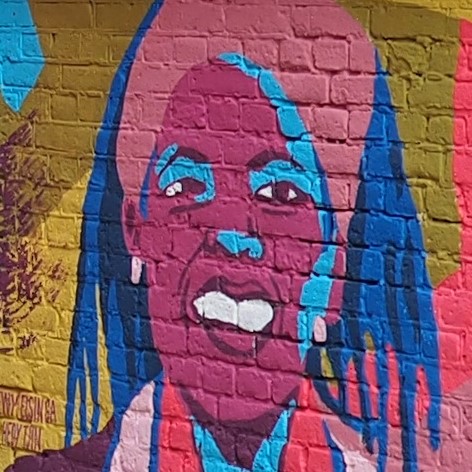A blog about (hidden) Amsterdam
A blog about (hidden) Amsterdam
“The Wall of Surinamese and Black Heroes” is a beautiful mural by Hedy Tijn & Dewy “Butterfingaz” Elsinga at the entrance to the Black Archives at the Hugo Olijfveldhuis. We want everyone to know their stories. Up next is Cindy Kerseborn, shining a light on Caribbean literature.

There is something astonishing about a capable and determined person who pours all of their energy not into their own legacy but someone else’s. To be honest, I can only think of a few. Joan of Arc’s mother was a peasant woman whose crusade for her daughter’s story took her to the Papal Court and the French one before eventually achieving an unheard reversal of a heresy trial. After half a lifetime at the center of Golden Age artistic circles, Anna Roemers Visscher spent the second half of her life translating female writers so they could inspire each other. And in 21st-century Amsterdam, Cindy Kerseborn used her considerable drive and documentary skill to wrestle the spotlight onto Caribbean writers.
Cindy Kerseborn was born in Paramaribo in 1956. Her father was a nurse in Suriname’s oldest hospital and a believer in helping anyone in need. Cindy would later describe the adults and children who would become part of the household for a year or two as they navigated a crisis. When Cindy was seventeen years old, she moved to the Netherlands to get her diploma in psychiatric nursing. She worked at a hospital in Amsterdam for several years before a job at a clipping service introduced her to the media.
Intrigued, she studied television at Hilversum’s media academia and went on to be an editor at the NOS, the RVU, Human, IKON and Migranten Television Amsterdam. In the 2000s, in her early 50s and after the passing of her husband, she embarked on the series that would become her most impactful work.
As her partner, Abram de Swaan, would later say, “She wanted to put Caribbean literature on the map.” She began with Edgar Cairo, a prolific and poetic Surinamese writer whose ruminations on the painful legacy of colonialism were challenging for Dutch readers. Meanwhile, his reflections on Surinamese society and the December murders under dictator Dési Bouterse challenged Surinamese authorities, especially after Bouterse returned to power. Those two facts, combined with his creative use of Dutch and the Surinamese lingua franca Sranantongo, meant that his impactful body of work got less attention than it deserved.
On the tenth anniversary of his death in 2011, Cindy premiered her documentary about him, laying the pattern for the rest of her life. She founded the Cimaké Foundation to realize her vision of programming around documentaries. Her films would debut with a full slate of debates, educational programs, literary festivals and exhibitions.
Just two years later, she debuted her next film. This one was about award-winning Curacoan poet and novelist Frank Martinus Arion, who wrote in both Dutch and the lingua franca of Curacao. Like Edgar Cairo, Arion’s work could be challenging in the Netherlands, and he was an outspoken critic of the Dutch government’s treatment of the Antilles. Decades’ worth of his acclaimed work had been marginalized in Dutch literary circles. Cindy’s film brought it back into focus.
Perhaps the most impactful of Cindy’s films was her final film about Surinamese poet Astrid Roemer. She is a Surinamese poet, novelist and playwright whose work was ground-breaking in its discussion of the lives of women and migrants, as well as the history of Suriname. She’s avoided the public for more than fifteen years. Cindy’s search for Roemer took her from the Isle of Skye to a Belgian monastery.
In a later interview, Cindy explained why she believed in protecting privacy, even of her documentary subjects. “[Astrid Roemer] opened doors for migrant women and brought attention to sexism and the exclusion of women in the workplace. She was the first woman to explore the complex history of Suriname in a novel form. She did it in an intellectual and, at the same time, a sensual and poetic way. She seemed to have disappeared from the face of the earth for fifteen years. I found her and became very close to her. I don’t mention all of her pain [in the film], but I leave it to the viewer to feel.”
The film, which debuted in 2015, brought Roemer’s work to a new generation and caused her work to be reevaluated by the literary establishment. In 2016, Roemer was awarded the PC Hooft prize – the Netherlands’ highest literary honor – over the more establishment candidate.
Cindy Kerseborn has one other thing in common with Anna Roemers Visscher and Joan of Arc’s mother. All three were in the latter part of their lives when they revived their subjects’ legacies. From the medieval through the early modern to today, these three women form a chain that shows not only generosity of spirit but what women can achieve in middle age.
We hope you’ll join us someday on our Hidden Gems Tour, where you can learn about more incredible people like Cindy Kerseborn.
Check out some more Blamsterdam! posts.
Private Museum Tour
See the highlights and hidden icons of Amsterdam’s world-renowned Rijksmuseum in a private guided tour that explores who creates art and what stories it’s used to tell. And don’t worry about museum tickets. We’ve got you covered.


Small-Group Walking Tour
This historical tour through the busy Jewish quarter and residential Plantage neighborhood offers a selection of stories from BIPOC, LGBTQ+, Jewish and women’s history. It’s the perfect way to get an alternative view of Amsterdam.


Self-Guided Digital Tour
Use your phone to explore Amsterdam! This self-guided tour uses audio, images, maps, and text to introduce you to the women, BIPOC, LGBTQ+, and Jewish people who made Amsterdam what it is.


Small-Group Walking Tour
In 1593, Jewish Amsterdammers began building a community in the relative safety of the city that transformed both the Netherlands and the world. Learn about these creative, compassionate, and challenging mavericks and their impact.


Small-Group Walking Tour
The women who shaped Amsterdam are more complex than traditional tours would have you believe. Go to Amsterdam’s historic sites to hear stories of women who fought, wrote, calculated and led through the city’s chaotic and complicated past.


Small-Group Walking Tour
The world’s first gay marriage was officiated by the Mayor of Amsterdam at its City Hall. But did you know that the city’s LGBTQ+ history stretches centuries? Meet historical Amsterdammers across the gender spectrum and sexual orientations.


Private Walking Tour
Get a personalized tour that covers the interests you’re curious about and the neighborhoods you want to see. Choose pick-up/drop-off locations, any combination of our hidden history topics, and themes such as artists, politicians, and rebels.

